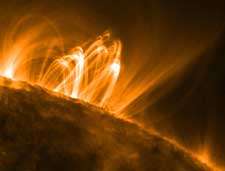Researchers make magnetic fields breakthrough

(PhysOrg.com) -- Researchers at the University of Dundee have made a breakthrough in the study of magnetic fields, which enhances our understanding of how stars, including the Sun, work.
The team from the Magnetohydrodynamics research group in the School of Engineering, Physics and Mathematics used state-of-the-art computer simulations of evolving plasmas in the Sun's atmosphere.
By following how the magnetic field and the plasma interact, they have uncovered new rules that govern what evolutions are possible. Knowing the basic rules behind the apparently complex solar atmosphere gives the team hope of predicting how it will behave.
Magnetic fields cannot be directly seen, felt or tasted, but they are a ubiquitous force of nature. The neat pattern of magnetic "field lines" from a bar magnet is well-known from school physics experiments. Indeed, the magnetic field of the Earth itself has a similar pattern on a much larger scale, which is what enables navigation by compass.
But magnetic fields are not always so ordered. Telescopic pictures of the Sun's lower atmosphere taken in extreme-ultraviolet light, outside the visible spectrum, reveal the shape of the magnetic field lines because the plasma particles emitting the light are guided by magnetic forces and move along the magnetic field lines.
These images often reveal braiding and tangling of the field, in a manner that would render a compass useless. The fact that the magnetic field lines are tangled like spaghetti means that the plasma in the Sun's atmosphere is not free to move around however it pleases and that vast quantities of energy can be locked in the magnetic field, because tangled fields have more energy than ordered fields.
Scientists believe that this energy is responsible for heating the Sun’s atmosphere to million-degree temperatures, but how this works in detail is a longstanding puzzle in solar physics. The Dundee team hope their discovery will give us a better idea of just how this energy is released.
'Using these computer simulations, we have studied braided magnetic fields and made a significant advance in understanding how they evolve over time,' said Dr Gunnar Hornig, one of the paper’s authors.
'You can observe magnetic fields on the Sun with satellites and see that these structures are often braided. That is they are not just simple loops, but these loops interlink.
'These structures are not static. They evolve because the Sun is not a rigid body but essentially a plasma ball of gas. It kind of boils, and the motion on the surface changes these magnetic structures. They start to move them around and sometimes the braiding is increased. And if certain critical conditions are met then these structures start to relax to something simpler.
'If you take a twig of a branch and start to twist it, then at some point it starts to break and the individual fibres break up. Something similar happens to these magnetic fields. Where it differs is that the evolutions we have been studying allow the broken fields to combine to form new structures.'
Having investigated how magnetic field braiding works in a specific instance, the team will now switch their attention to examining how they work in more general, complex structures.
'We began by looking at braided magnetic fields in the Sun’s atmosphere,' explained Dr Anthony Yeates, one of the team members. 'We know that these magnetic fields break up and reconnect and we have now discovered new rules governing which evolutions are possible and how this is happening.
'This is fundamental research - part of the theory of astrophysical plasmas. It forms part of our attempts to understand how stars work, which enhances our understanding of how our own Sun evolves, and how it affects the climate and life on Earth.'
Their research has been published in the latest edition of Physical Review Letters, as a paper entitled 'Topological constraints on magnetic relaxation'.
The ongoing research project on quantifying magnetic fluxes started last October, and is funded by the Science and Technology Facilities Council.
Provided by University of Dundee

















